Clay-Based Nanocomposite Hydrogels for Biomedical Applications: A Review
Abstract
1. Introduction
1.1. Hydrogels
1.2. Clay Nanoparticles
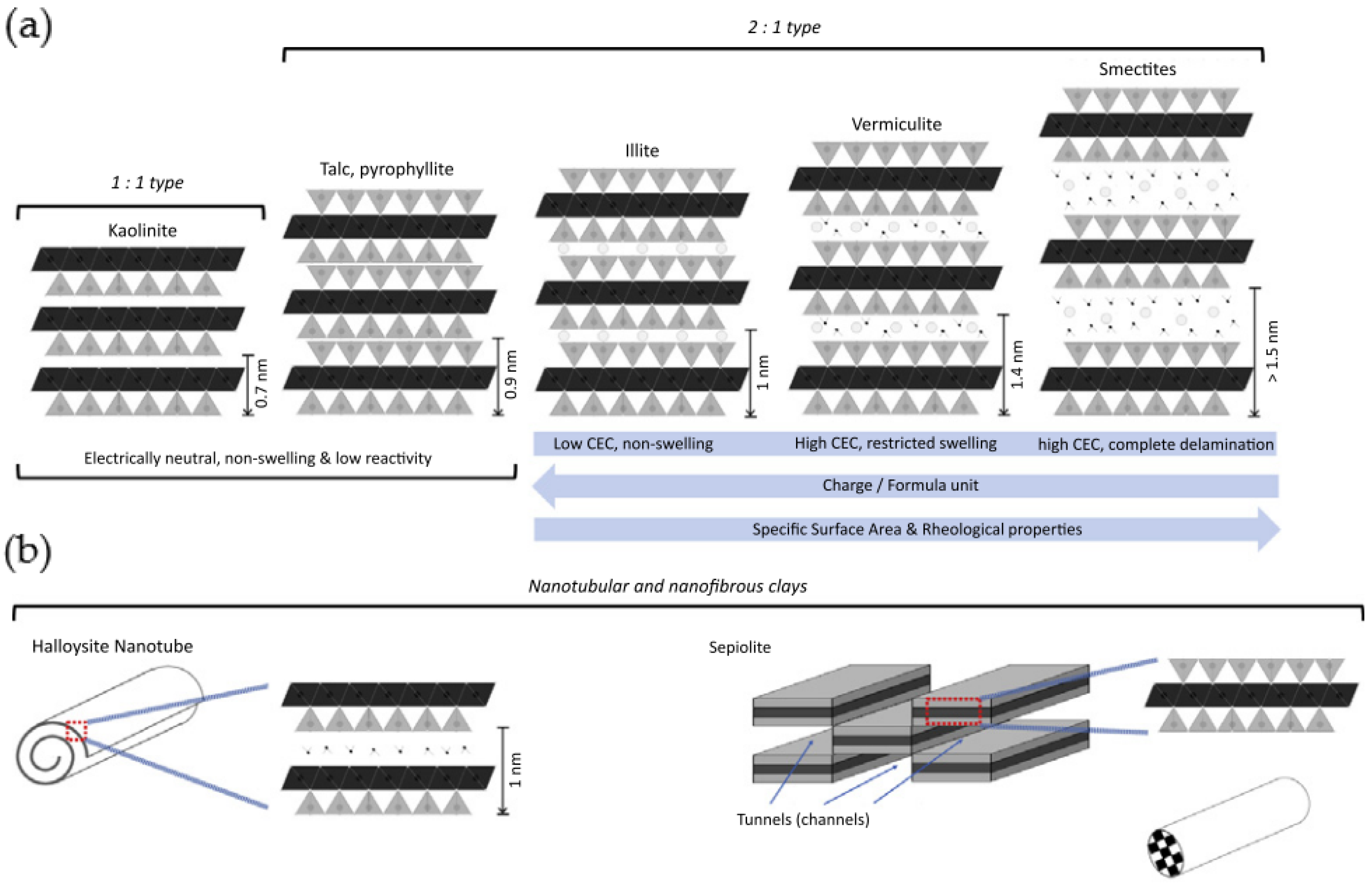
1.3. Clay-Based Nanocomposite Hydrogels
2. Nanocomposites Features and Characterization
2.1. Synthesis
2.2. Swelling
2.3. Rheological Behavior
2.4. Structural Integrity
2.5. Degradation
2.6. Morphology
2.7. Encapsulation/Release
2.8. Cell Dynamics
3. Fields of Application
3.1. Tissue Engineering
3.2. Bone Tissue Engineering
| Hydrogel | Clay | Features/Observation | Ref |
|---|---|---|---|
| Chitosan glycerophosphate | HNT | Icariin (IC), a bone inducer, was loaded into modified-HNTs (mHNTs), resulting in a sustained drug release system; Modification of HNTs with chitosan increased entrapment efficiency and loading capacity with reduced initial burst release of IC. The nanocomposite chitosan/mHNTs displayed decreased gelation time and temperature, enhanced mechanical strength, improved proliferation, and bone differentiation of hASCs and hMSCs encapsulated in the resulting scaffolds. | [83] |
| Poly(4-acryloylmorpholine) | Laponite | The clay-based nanocomposite displayed excellent mechanical properties, good biocompatibility, sustainable release of bioactive ions (intrinsic Mg2+ and Si4+), ability to promote osteogenic differentiation of ROBs and effective formation of new bone after implantation. | [81] |
| PNAGA | Laponite | Implantation of 3D-printed scaffold showed sustainable release of intrinsic ions and osteogenic differentiation of ROBs, which facilitated the regeneration of new bone in tibia defects of rats. | [54] |
| GeIMA | nSi | Nanoengineered collagen-based matrix reinforced with nanosilicates displayed osteogenic differentiation (in absence of any osteoinduction factors), and improved migration and proliferation of hMSCs. | [68] |
| AGMA1 | MMT | Fully swollen AGMA1–MMT hydrogels showed storage modulus (G′) values up to 20 times higher than common biomimetic hydrogels; The nanocomposite was completely degradable with no cytotoxicity, supported cell adhesion and proliferation and induced osteogenic differentiation of mouse calvaria-derived pre-osteoblastic cells (MC3T3-E1). | [69] |
| Collagen-based GelMA | Laponite | Clay nanoparticles enhanced the formation of mineralized matrix (in a growth factor-free environment); Laponite addition increased porosity, improved scaffolds stiffness (four-fold increase in compressive modulus) and injectability. | [84] |
| Silk fibroin | Laponite | The composite hydrogel can be recovered within 70 s after shearing with 3000% strain, for at least 6 successive repeats. Incorporation of laponite nanoparticles promoted osteogenic differentiation of primary osteoblast in the regenerated silk fibroin-based scaffold. | [62] |
| PEGDA | Laponite | The lamellar and porous nanocomposite hydrogel exhibited in vivo bone healing capacity with the formation of intramembranous bone in a defect model of the tibiae of osteopenic rats. The Artemia salina lethality assays demonstrated no toxicity. | [85] |
3.3. Cartilage Tissue Regeneration
| Hydrogel | Clay | Features/Observation | Ref |
|---|---|---|---|
| GG + antibacterial MH | HNT + BE + MS | Incorporation of inorganic clays significantly improved the mechanical properties. No severe immune response was caused, and the infection was restrained; MS provided the best combination in terms of in vitro cytocompatibility, mechanical performances, and morphological features; GG-MH-MS tested in co-culture preserved hMSCs’ proliferation over bacteria. | [92] |
| MκCA | 2D nanosilicates | Nanocomposite hydrogel as an injectable for cellular delivery; The strong interaction between polymer chains and nanosilicates resulted in nanocomposites with shear-thinning characteristics, reinforced hydrogel networks, elastomeric properties, physiological stability, and high cell viability after injection. | [93] |
| PEG | Laponite | The presence of silicate enhanced bioactivity, cell adhesion, spreading, and growth as well as the adhesiveness of the hydrogel to soft tissue and hard surfaces. | [65] |
| Si-HPMC | Laponite | Interpenetrating network enhances the hydrogel mechanical properties without interfering with its cytocompatibility, oxygen diffusion, or the ability of chondrogenic cells to self-organize in the cluster and produce ECM. | [94] |
| pNIPAAM | LDHs | pNIPAAM-based hydrogel capable of delivering siRNA using LDH platelets. The injectable and thermo-responsive properties of the hydrogel allowed it to be administered locally in a minimally invasive manner, thus providing a strategy for the in vivo treatment of degeneration in cartilaginous tissues. | [95] |
| PEO | Laponite | An increase in mineralized phosphate produced on the bioactive nanocomposite surfaces indicated that the silicate nanoparticles influence the differentiation of preosteoblast cells. | [57] |
| PEG | Laponite | The nanocomposites exhibited biocompatibility, scaffold ability to withstand load and stress from native cartilage (collagen type II), due to clay nanoparticle exfoliation, and enhanced storage modulus. | [96] |
3.4. Drug Delivery
| Hydrogel | Clay | Features/Observation | Ref |
|---|---|---|---|
| Chitosan | MMT | MMT addition to pristine chitosan hydrogel beads enhanced their stability and disintegration performance, improved the swelling behavior, increased ofloxacin entrapment, and promoted a sustainable drug release profile. | [73] |
| (PLGA-PEG-PLGA) | CNDs | A single injection of the biodegradable gel provided sustained DOX antitumor activity in nude mice and significant tumor reduction compared to control. | [98] |
| Alginate | Laponite | The addition of laponite nanoparticles substantially hindered the burst release of the adsorbed protein cargo from alginate cryogels and exhibited sustained release kinetics when compared with unreinforced hydrogels. | [72] |
| Sodium alginate | Laponite | The nanocomposite hydrogel exhibited increased encapsulation of IGF1 mimetic protein, biocompatibility with surrounding environment, sustained and localized drug release for tendon injury with simultaneous biodegradability. | [74] |
| Gelatin methacrylate | Laponite | Nanoclay incorporation in hydrogel improved the ability to modulate the release of key growth factors (present in stem cell derived secretome) and provide angiogenic and cardioprotective therapeutic ability. | [109] |
| HEMA | MMT | Compared to pristine HEMA hydrogels, the burst release of paracetamol from the HEMA/MMT nanocomposites was significantly reduced and its release time increased. | [110] |
| Sodium hyaluronate + HEMA | HNT | 5-FU was encapsulated successfully into these hydrogels as well as inside the halloysite nanotubes through equilibrium swelling. The nanocomposite hydrogel exhibited pH sensitivity, uniform stabilization ability of the HNT in the hydrogel networks, 5-FU release in the gastric region and in the intestinal fluid in a controlled manner for over 70 h. | [111] |
| CMC | MMT | Nanocomposite hydrogel beads, composed of propanol intercalated clays and CMC, exhibited sustained release and high bead stability against simulated stomach acid and intestinal conditions. | [112] |
| CS + AA + AAm + PVP | MMT | A sustained drug release profile was obtained in the presence of MMT nanoparticles, maintaining clarithromycin concentration in a simulated gastric environment for prolonged periods of time. | [58] |
| PAAm | Laponite | Polyampholyte hydrogels reinforced with laponite were characterized for their sensitivity to external conditions and their ability to electrically control the release of the active paracetamol drug agent | [113] |
| CMC-g-PAA | Organo-MMT nanoclay | The presence of clay nanoparticles enhanced mechanical properties and in vitro blood compatibility. The release behavior of vitamin B12 was dependent on the nanocomposite cross-linking density and medium pH. | [51] |
3.5. Wound Healing
| Hydrogel | Clay | Features/Observation | Ref |
|---|---|---|---|
| PVA | Laponite | Incorporation of small amounts of laponite enhanced the rheological and mechanical properties, with a high capacity of structural regeneration (about 90%) after applying a large deformation, high water absorption capacity (900%) and improved antibacterial activity; Rifampicin release mechanism from hydrogels is dependent on clay concentration. | [124] |
| Gelatin | Laponite | By reinforcing gelatin biopolymers with laponite nanoplatelets, injectable hemostatic agents were developed to treat incompressible wounds in emergency circumstances; Clay particles conveyed physiological stability, rapid mechanical recovery, and ability to promote coagulation, thus being a stable clot-gel systems (decreased in vitro blood clotting time by 77%). | [114] |
| PVA | Na-MMT | Clay nanoparticles act as barriers against microbe penetration which enhances the protection against further wound infection and accelerates the wound healing process. | [52] |
| Silk sericin + pNIPAAm) | Lithium magnesium silicate hydrate | Compared with gauze, the nanoclay crosslinked nanocomposite hydrogel accelerated wound healing, hence having extensive applications in clinical medical wound dressing. | [125] |
| Polyacrylamide | Dopamine intercalated Clay nanosheets | The adhesive composite hydrogel exhibited resilience, strong adhesion, high stretchability, easy removal without hurting skin (allowing on-demand removal), favorable cell adhesion and proliferation as well as full-thickness skin wound regeneration. | [126] |
| Poly(2 methoxyethyl acrylate-co-N,N-dimethylacrylamide) | Hectorite | Due to their thermo-sensitivity, controllable modulus, and surface properties, the nanocomposite gels were promising cell culture substrates. Nanocomposite film hydrogels demonstrated excellent soft and flexible tensile strength, high elongation (more than 1000%) without suppressing the transparency. | [127] |
| PAM | MMT | The ozone-loaded nanocomposite hydrogels exhibited long-term antibacterial activity, protection against skin infection, and a favorable environment for wound healing. | [128] |
3.6. 3D Bio Printing
3.7. Biosensors and Actuators
4. Conclusions
Author Contributions
Funding
Institutional Review Board Statement
Informed Consent Statement
Data Availability Statement
Conflicts of Interest
References
- Tutar, R.; Motealleh, A.; Khademhosseini, A.; Kehr, N.S. Functional Nanomaterials on 2D Surfaces and in 3D Nanocomposite Hydrogels for Biomedical Applications. In Advanced Functional Materials; Wiley-VCH Verlag: Weinheim, Germany, 2019; Volume 29. [Google Scholar]
- Vashist, A.; Kaushik, A.; Ghosal, A.; Bala, J.; Nikkhah-Moshaie, R.; Wani, W.A.; Manickam, P.; Nair, M. Nanocomposite Hydrogels: Advances in Nanofillers Used for Nanomedicine. Gels 2018, 4, 75. [Google Scholar] [CrossRef] [PubMed]
- Utech, S.; Boccaccini, A.R. A review of hydrogel-based composites for biomedical applications: Enhancement of hydrogel properties by addition of rigid inorganic fillers. In Journal of Materials Science; Springer: New York, NY, USA, 2016; Volume 51, pp. 271–310. [Google Scholar]
- Ullah, F.; Othman, M.B.H.; Javed, F.; Ahmad, Z.; Akil, H.M. Classification, processing and application of hydrogels: A review. Mater. Sci. Eng. C 2015, 57, 414–433. [Google Scholar] [CrossRef] [PubMed]
- Ganguly, S.; Das, P.; Das, N.C. Characterization Tools and Techniques of Hydrogels; Elsevier: Amsterdam, The Netherlands, 2019. [Google Scholar]
- Mahinroosta, M.; Farsangi, Z.J.; Allahverdi, A.; Shakoori, Z. Hydrogels as intelligent materials: A brief review of synthesis, properties and applications. Mater. Today Chem. 2018, 8, 42–55. [Google Scholar] [CrossRef]
- Varaprasad, K.; Raghavendra, G.M.; Jayaramudu, T.; Yallapu, M.M.; Sadiku, R. A mini review on hydrogels classification and recent developments in miscellaneous applications. Mater. Sci. Eng. C 2017, 79, 958–971. [Google Scholar] [CrossRef]
- Feksa, L.R.; Troian, E.A.; Muller, C.D.; Viegas, F.; Machado, A.B.; Rech, V.C. Hydrogels for biomedical applications. In Nanostructures for the Engineering of Cells, Tissues and Organs: From Design to Applications; Elsevier: Amsterdam, The Netherlands, 2018; pp. 403–438. [Google Scholar]
- MacHín, R.; Isasi, J.R.; Vélaz, I. β-Cyclodextrin hydrogels as potential drug delivery systems. Carbohydr. Polym. 2012, 87, 2024–2030. [Google Scholar] [CrossRef]
- Barrett-Catton, E.; Ross, M.L.; Asuri, P. Multifunctional hydrogel nanocomposites for biomedical applications. Polymers 2021, 13, 856. [Google Scholar] [CrossRef]
- Kamata, H.; Li, X.; Chung, U.I.; Sakai, T. Design of Hydrogels for Biomedical Applications. Adv. Healthc. Mater. 2015, 4, 2360–2374. [Google Scholar] [CrossRef]
- Mathew, A.P.; Uthaman, S.; Cho, K.H.; Cho, C.S.; Park, I.K. Injectable hydrogels for delivering biotherapeutic molecules. Int. J. Biol. Macromol. 2018, 110, 17–29. [Google Scholar] [CrossRef]
- Bhattarai, N.; Gunn, J.; Zhang, M. Chitosan-based hydrogels for controlled, localized drug delivery. Adv. Drug Deliv. Rev. 2010, 62, 83–99. [Google Scholar] [CrossRef]
- Asadi, N.; Alizadeh, E.; Salehi, R.; Khalandi, B.; Davaran, S.; Akbarzadeh, A. Nanocomposite hydrogels for cartilage tissue engineering: A review. In Artificial Cells, Nanomedicine and Biotechnology; Taylor and Francis Ltd.: Abingdon, UK, 2018; Volume 46, pp. 465–471. [Google Scholar]
- Memic, A.; Alhadrami, H.A.; Hussain, M.A.; Aldhahri, M.; Al Nowaiser, F.; Al-Hazmi, F.; Oklu, R.; Khademhosseini, A. Hydrogels 2.0: Improved properties with nanomaterial composites for biomedical applications. Biomed. Mater. 2015, 11, 014104. [Google Scholar] [CrossRef]
- Fuchs, S.; Shariati, K.; Ma, M. Specialty Tough Hydrogels and Their Biomedical Applications. In Advanced Healthcare Materials; Wiley-VCH Verlag: Weinheim, Germany, 2020; Volume 9. [Google Scholar]
- Pavlidou, S.; Papaspyrides, C.D. A review on polymer-layered silicate nanocomposites. Prog. Polym. Sci. 2008, 33, 1119–1198. [Google Scholar] [CrossRef]
- Katti, K.S.; Jasuja, H.; Jaswandkar, S.; Mohanty, S.; Katti, D.R. Nanoclays in Medicine: A New Frontier of an Ancient Medical Practice. Mater. Adv. 2022. [Google Scholar] [CrossRef]
- Mousavi, S.M.; Hashemi, S.A.; Salahi, S.; Hosseini, M.; Amani, A.M.; Babapoor, A. Development of Clay Nanoparticles Toward Bio and Medical Applications. In Current Topics in the Utilization of Clay in Industrial and Medical Applications; InTech: London, UK, 2018. [Google Scholar]
- Dong, J.; Cheng, Z.; Tan, S.; Zhu, Q. Clay nanoparticles as pharmaceutical carriers in drug delivery systems. In Expert Opinion on Drug Delivery; Taylor and Francis Ltd.: Abingdon, UK, 2021; Volume 18, pp. 695–714. [Google Scholar]
- Peña-Parás, L.; Sánchez-Fernández, J.A.; Vidaltamayo, R. Nanoclays for Biomedical Applications. In Handbook of Ecomaterials; Springer International Publishing: New York, NY, USA, 2018; pp. 1–19. [Google Scholar]
- Sandri, G.; Bonferoni, M.C.; Rossi, S.; Ferrari, F.; Aguzzi, C.; Viseras, C.; Caramella, C. Clay minerals for tissue regeneration, repair, and engineering. In Wound Healing Biomaterials; Elsevier: Amsterdam, The Netherlands, 2016; Volume 2, pp. 385–402. [Google Scholar]
- Saikia, P. Clay nanostructures for biomedical applications. In Two-Dimensional Nanostructures for Biomedical Technology: A Bridge between Material Science and Bioengineering; Elsevier: Amsterdam, The Netherlands, 2019; pp. 137–172. [Google Scholar]
- Choi, G.; Piao, H.; Eom, S.; Choy, J.H. Vectorized Clay Nanoparticles in Therapy and Diagnosis. Clays Clay Miner. 2019, 67, 25–43. [Google Scholar] [CrossRef]
- Mallakpour, S.; Rashidimoghadam, S. Recent developments in the synthesis of hybrid polymer/clay nanocomposites: Properties and applications. In Hybrid Polymer Composite Materials: Applications; Elsevier: Amsterdam, The Netherlands, 2017; pp. 227–265. [Google Scholar]
- Murali, A.; Lokhande, G.; Deo, K.A.; Brokesh, A.; Gaharwar, A.K. Emerging 2D nanomaterials for biomedical applications. In Materials Today; Elsevier: Amsterdam, The Netherlands, 2021; Volume 50, pp. 276–302. [Google Scholar]
- Kim, T.; Kim, S.; Lee, D.K.; Seo, B.; Lim, C.S. Surface treatment of halloysite nanotubes with sol-gel reaction for the preparation of epoxy composites. RSC Adv. 2017, 7, 47636–47642. [Google Scholar] [CrossRef]
- Murugesan, S.; Scheibel, T. Copolymer/Clay Nanocomposites for Biomedical Applications. In Advanced Functional Materials; Wiley-VCH Verlag: Weinheim, Germany, 2020; Volume 30. [Google Scholar]
- Mousa, M.; Evans, N.D.; Oreffo, R.O.C.; Dawson, J.I. Clay nanoparticles for regenerative medicine and biomaterial design: A review of clay bioactivity. In Biomaterials; Elsevier: Amsterdam, The Netherlands, 2018; Volume 159, pp. 204–214. [Google Scholar]
- Kim, M.H.; Choi, G.; Elzatahry, A.; Vinu, A.; Choy, Y.B.; Choy, J.H. Review of clay-drug hybrid materials for biomedical applications: Administration routes. Clays Clay Miner. 2016, 64, 115–130. [Google Scholar] [CrossRef]
- Chrzanowski, W.; Kim, S.Y.; Abou Neel, E.A. Biomedical applications of clay. Aust. J. Chem. 2013, 66, 1315–1322. [Google Scholar] [CrossRef]
- Khatoon, N.; Chu, M.Q.; Zhou, C.H. Nanoclay-based drug delivery systems and their therapeutic potentials. In Journal of Materials Chemistry B; Royal Society of Chemistry: London, UK, 2020; Volume 8, pp. 7335–7351. [Google Scholar]
- Viseras, C.; Carazo, E.; Borrego-Sánchez, A.; García-Villén, F.; Sánchez-Espejo, R.; Cerezo, P.; Aguzzi, C. Clay minerals in skin drug delivery. Clays Clay Miner. 2019, 67, 59–71. [Google Scholar] [CrossRef]
- Ruiz-Hitzky, E.; Darder, M.; Wicklein, B.; Castro-Smirnov, F.A.; Aranda, P. Clay-based biohybrid materials for biomedical and pharmaceutical applications. Clays Clay Miner. 2019, 67, 44–58. [Google Scholar] [CrossRef]
- Santos, A.C.; Pereira, I.; Reis, S.; Veiga, F.; Saleh, M.; Lvov, Y. Biomedical potential of clay nanotube formulations and their toxicity assessment. In Expert Opinion on Drug Delivery; Taylor and Francis Ltd.: Abingdon, UK, 2019; Volume 16, pp. 1169–1182. [Google Scholar]
- Jayrajsinh, S.; Shankar, G.; Agrawal, Y.K.; Bakre, L. Montmorillonite nanoclay as a multifaceted drug-delivery carrier: A review. J. Drug Deliv. Sci. Technol. 2017, 39, 200–209. [Google Scholar] [CrossRef]
- Tomás, H.; Alves, C.S.; Rodrigues, J. Laponite®: A key nanoplatform for biomedical applications? In Nanomedicine: Nanotechnology, Biology, and Medicine; Elsevier: Amsterdam, The Netherlands, 2018; Volume 14, pp. 2407–2420. [Google Scholar]
- Hu, T.; Mei, X.; Wang, Y.; Weng, X.; Liang, R.; Wei, M. Two-dimensional nanomaterials: Fascinating materials in biomedical field. In Science Bulletin; Elsevier: Amsterdam, The Netherlands, 2019; Volume 64, pp. 1707–1727. [Google Scholar]
- Gibbs, D.M.R.; Black, C.R.M.; Hulsart-Billstrom, G.; Shi, P.; Scarpa, E.; Oreffo, R.O.C.; Dawson, J.I. Bone induction at physiological doses of BMP through localization by clay nanoparticle gels. Biomaterials 2016, 99, 16–23. [Google Scholar] [CrossRef]
- Zhao, L.Z.; Zhou, C.H.; Wang, J.; Tong, D.S.; Yu, W.H.; Wang, H. Recent advances in clay mineral-containing nanocomposite hydrogels. Soft Matter 2015, 11, 9229–9246. [Google Scholar] [CrossRef] [PubMed]
- Naahidi, S.; Jafari, M.; Logan, M.; Wang, Y.; Yuan, Y.; Bae, H.; Dixon, B.; Chen, P. Biocompatibility of hydrogel-based scaffolds for tissue engineering applications. Biotechnol. Adv. 2017, 35, 530–544. [Google Scholar] [CrossRef] [PubMed]
- Wu, C.J.; Gaharwar, A.K.; Schexnailder, P.J.; Schmidt, G. Development of biomedical polymer-silicate nanocomposites: A materials science perspective. Materials 2010, 3, 2986–3005. [Google Scholar] [CrossRef]
- Rafieian, S.; Mirzadeh, H.; Mahdavi, H.; Masoumi, M.E. A review on nanocomposite hydrogels and their biomedical applications. In IEEE Journal of Selected Topics in Quantum Electronics; Institute of Electrical and Electronics Engineers Inc.: Piscataway, NJ, USA, 2019; Volume 26, pp. 154–174. [Google Scholar]
- Song, F.; Li, X.; Wang, Q.; Liao, L.; Zhang, C. Nanocomposite hydrogels and their applications in drug delivery and tissue engineering. In Journal of Biomedical Nanotechnology; American Scientific Publishers: Santa Clarita, CA, USA, 2015; Volume 11, pp. 40–52. [Google Scholar]
- Thoniyot, P.; Tan, M.J.; Karim, A.A.; Young, D.J.; Loh, X.J. Nanoparticle–Hydrogel Composites: Concept, Design, and Applications of These Promising, Multi-Functional Materials. In Advanced Science; Wiley-VCH Verlag: Weinheim, Germany, 2015; Volume 2. [Google Scholar]
- Gârea, S.A.; Voicu, A.I.; Iovu, H. Clay-Polymer Nanocomposites for Controlled Drug Release. In Clay-Polymer Nanocomposites; Elsevier: Amsterdam, The Netherlands, 2017; pp. 475–509. [Google Scholar]
- Kevadiya, B.D.; Patel, T.A.; Jhala, D.D.; Thumbar, R.P.; Brahmbhatt, H.; Pandya, M.P.; Rajkumar, S.; Jena, P.K.; Joshi, G.V.; Gadhia, P.K.; et al. Layered inorganic nanocomposites: A promising carrier for 5-fluorouracil (5-FU). Eur. J. Pharm. Biopharm. 2012, 81, 91–101. [Google Scholar] [CrossRef] [PubMed]
- Valapa, R.B.; Loganathan, S.; Pugazhenthi, G.; Thomas, S.; Varghese, T.O. An Overview of Polymer-Clay Nanocomposites; Elsevier: Amsterdam, The Netherlands, 2017. [Google Scholar]
- Sakr, M.A.; Mohamed, M.G.; Wu, R.; Shin, S.R.; Kim, D.; Kim, K.; Siddiqua, S. Development of bentonite-gelatin nanocomposite hybrid hydrogels for tissue engineering. Appl. Clay Sci. 2020, 199, 105860. [Google Scholar] [CrossRef]
- Fernandes, R.d.; de Moura, M.R.; Glenn, G.M.; Aouada, F.A. Thermal, microstructural, and spectroscopic analysis of Ca2+ alginate/clay nanocomposite hydrogel beads. J. Mol. Liq. 2018, 265, 327–336. [Google Scholar] [CrossRef]
- Boruah, M.; Gogoi, P.; Manhar, A.K.; Khannam, M.; Mandal, M.; Dolui, S.K. Biocompatible carboxymethylcellulose-g-poly(acrylic acid)/OMMT nanocomposite hydrogel for in vitro release of vitamin B12. RSC Adv. 2014, 4, 43865–43873. [Google Scholar] [CrossRef]
- Kokabi, M.; Sirousazar, M.; Hassan, Z.M. PVA-clay nanocomposite hydrogels for wound dressing. Eur. Polym. J. 2007, 43, 773–781. [Google Scholar] [CrossRef]
- Vázquez-Aristizabal, P.; Perumal, G.; García-Astrain, C.; Liz-Marzán, L.M.; Izeta, A. Trends in Tissue Bioprinting, Cell-Laden Bioink Formulation, and Cell Tracking. ACS Omega 2022, 7, 16236–16243. [Google Scholar] [CrossRef]
- Zhai, X.; Ma, Y.; Hou, C.; Gao, F.; Zhang, Y.; Ruan, C.; Pan, H.; Lu, W.W.; Liu, W. 3D-printed high strength bioactive supramolecular polymer/ clay nanocomposite hydrogel scaffold for bone regeneration. ACS Biomater. Sci. Eng. 2017, 3, 1109–1118. [Google Scholar] [CrossRef]
- Nadernezhad, A.; Caliskan, O.S.; Topuz, F.; Afghah, F.; Erman, B.; Koc, B. Nanocomposite Bioinks Based on Agarose and 2D Nanosilicates with Tunable Flow Properties and Bioactivity for 3D Bioprinting. ACS Appl. Bio. Mater. 2019, 2, 796–806. [Google Scholar] [CrossRef] [PubMed]
- Hu, C.; Hahn, L.; Yang, M.; Altmann, A.; Stahlhut, P.; Groll, J.; Luxenhofer, R. Improving printability of a thermoresponsive hydrogel biomaterial ink by nanoclay addition. J. Mater. Sci. 2021, 56, 691–705. [Google Scholar] [CrossRef]
- Gaharwar, A.K.; Schexnailder, P.J.; Kline, B.P.; Schmidt, G. Assessment of using Laponite® cross-linked poly(ethylene oxide) for controlled cell adhesion and mineralization. Acta Biomater. 2011, 7, 568–577. [Google Scholar] [CrossRef] [PubMed]
- Panahi, Y.; Gharekhani, A.; Hamishehkar, H.; Zakeri-Milani, P.; Gharekhani, H. Stomach-specific drug delivery of clarithromycin using a semi interpenetrating polymeric network hydrogel made of montmorillonite and chitosan: Synthesis, characterization and in vitro drug release study. Adv. Pharm. Bull. 2019, 9, 159–173. [Google Scholar] [CrossRef]
- Chaudhuri, S.D.; Mandal, A.; Dey, A.; Chakrabarty, D. Tuning the swelling and rheological attributes of bentonite clay modified starch grafted polyacrylic acid based hydrogel. Appl. Clay Sci. 2020, 185, 105405. [Google Scholar] [CrossRef]
- Huang, B.; Liu, M.; Long, Z.; Shen, Y.; Zhou, C. Effects of halloysite nanotubes on physical properties and cytocompatibility of alginate composite hydrogels. Mater. Sci. Eng. C 2017, 70, 303–310. [Google Scholar] [CrossRef]
- Huang, H.; Xu, J.; Wei, K.; Xu, Y.J.; Choi, C.K.K.; Zhu, M.; Bian, L. Bioactive Nanocomposite Poly (Ethylene Glycol) Hydrogels Crosslinked by Multifunctional Layered Double Hydroxides Nanocrosslinkers. Macromol. Biosci. 2016, 16, 1019–1026. [Google Scholar] [CrossRef]
- Su, D.; Jiang, L.; Chen, X.; Dong, J.; Shao, Z. Enhancing the Gelation and Bioactivity of Injectable Silk Fibroin Hydrogel with Laponite Nanoplatelets. ACS Appl. Mater. Interfaces 2016, 8, 9619–9628. [Google Scholar] [CrossRef]
- Wilson, S.A.; Cross, L.M.; Peak, C.W.; Gaharwar, A.K. Shear-Thinning and Thermo-Reversible Nanoengineered Inks for 3D Bioprinting. ACS Appl. Mater. Interfaces 2017, 9, 43449–43458. [Google Scholar] [CrossRef]
- Dávila, J.L.; d’Ávila, M.A. Rheological evaluation of Laponite/alginate inks for 3D extrusion-based printing. Int. J. Adv. Manuf. Technol. 2019, 101, 675–686. [Google Scholar] [CrossRef]
- Gaharwar, A.K.; Rivera, C.P.; Wu, C.J.; Schmidt, G. Transparent, elastomeric and tough hydrogels from poly(ethylene glycol) and silicate nanoparticles. Acta Biomater. 2011, 7, 4139–4148. [Google Scholar] [CrossRef] [PubMed]
- Cross, L.M.; Shah, K.; Palani, S.; Peak, C.W.; Gaharwar, A.K. Gradient nanocomposite hydrogels for interface tissue engineering. Nanomed. Nanotechnol. Biol. Med. 2018, 14, 2465–2474. [Google Scholar] [CrossRef] [PubMed]
- Kerativitayanan, P.; Gaharwar, A.K. Elastomeric and mechanically stiff nanocomposites from poly(glycerol sebacate) and bioactive nanosilicates. Acta Biomater. 2015, 26, 34–44. [Google Scholar] [CrossRef] [PubMed]
- Paul, A.; Manoharan, V.; Krafft, D.; Assmann, A.; Uquillas, J.A.; Shin, S.R.; Hasan, A.; Hussain, M.A.; Memic, A.; Gaharwar, A.K.; et al. Nanoengineered biomimetic hydrogels for guiding human stem cell osteogenesis in three dimensional microenvironments. J. Mater. Chem. B 2016, 4, 3544–3554. [Google Scholar] [CrossRef]
- Mauro, N.; Chiellini, F.; Bartoli, C.; Gazzarri, M.; Laus, M.; Antonioli, D.; Griffiths, P.; Manfredi, A.; Ranucci, E.; Ferruti, P. RGD-mimic polyamidoamine–montmorillonite composites with tunable stiffness as scaffolds for bone tissue-engineering applications. J. Tissue Eng. Regen. Med. 2017, 11, 2164–2175. [Google Scholar] [CrossRef] [PubMed]
- Eslahi, N.; Simchi, A.; Mehrjoo, M.; Shokrgozar, M.A.; Bonakdar, S. Hybrid cross-linked hydrogels based on fibrous protein/block copolymers and layered silicate nanoparticles: Tunable thermosensitivity, biodegradability and mechanical durability. RSC Adv. 2016, 6, 62944–62957. [Google Scholar] [CrossRef]
- Pereira, K.A.B.; Aguiar, K.L.N.P.; Oliveira, P.F.; Vicente, B.M.; Pedroni, L.G.; Mansur, C.R.E. Synthesis of Hydrogel Nanocomposites Based on Partially Hydrolyzed Polyacrylamide, Polyethyleneimine, and Modified Clay. ACS Appl. Mater. Interfaces 2020, 5, 4759–4769. [Google Scholar] [CrossRef]
- Koshy, S.T.; Zhang, D.K.Y.; Grolman, J.M.; Stafford, A.G.; Mooney, D.J. Injectable nanocomposite cryogels for versatile protein drug delivery. Acta Biomater. 2018, 65, 36–43. [Google Scholar] [CrossRef]
- Hua, S.; Yang, H.; Wang, W.; Wang, A. Controlled release of ofloxacin from chitosan-montmorillonite hydrogel. Appl. Clay Sci. 2010, 50, 112–117. [Google Scholar] [CrossRef]
- Li, J.; Weber, E.; Guth-Gundel, S.; Schuleit, M.; Kuttler, A.; Halleux, C.; Accart, N.; Doelemeyer, A.; Basler, A.; Tigani, B.; et al. Tough Composite Hydrogels with High Loading and Local Release of Biological Drugs. Adv. Healthc. Mater. 2018, 7, 1701393. [Google Scholar] [CrossRef]
- Gaharwar, A.K.; Kishore, V.; Rivera, C.; Bullock, W.; Wu, C.J.; Akkus, O.; Schmidt, G. Physically Crosslinked Nanocomposites from Silicate-Crosslinked PEO: Mechanical Properties and Osteogenic Differentiation of Human Mesenchymal Stem Cells. Macromol. Biosci. 2012, 12, 779–793. [Google Scholar] [CrossRef] [PubMed]
- Dong, L.; Bu, Z.; Xiong, Y.; Zhang, H.; Fang, J.; Hu, H.; Liu, Z.; Li, X. Facile extrusion 3D printing of gelatine methacrylate/Laponite nanocomposite hydrogel with high concentration nanoclay for bone tissue regeneration. Int. J. Biol. Macromol. 2021, 188, 72–81. [Google Scholar] [CrossRef]
- Same, S.; Nakhjavani, S.A.; Samee, G.; Navidi, G.; Jahanbani, Y.; Davaran, S. Halloysite clay nanotube in regenerative medicine for tissue and wound healing. Ceram. Int. 2022, 48, 31065–31079. [Google Scholar] [CrossRef]
- Liu, Y.; Meng, H.; Konst, S.; Sarmiento, R.; Rajachar, R.; Lee, B.P. Injectable dopamine-modified poly(ethylene glycol) nanocomposite hydrogel with enhanced adhesive property and bioactivity. ACS Appl. Mater. Interfaces 2014, 6, 16982–16992. [Google Scholar] [CrossRef] [PubMed]
- Bonifacio, M.A.; Gentile, P.; Ferreira, A.M.; Cometa, S.; De Giglio, E. Insight into halloysite nanotubes-loaded gellan gum hydrogels for soft tissue engineering applications. Carbohydr. Polym. 2017, 163, 280–291. [Google Scholar] [CrossRef]
- Chang, C.W.; van Spreeuwel, A.; Zhang, C.; Varghese, S. PEG/clay nanocomposite hydrogel: A mechanically robust tissue engineering scaffold. Soft Matter 2010, 6, 5157–5164. [Google Scholar] [CrossRef]
- Zhai, X.; Ruan, C.; Shen, J.; Zheng, C.; Zhao, X.; Pan, H.; Lu, W.W. Clay-based nanocomposite hydrogel with attractive mechanical properties and sustained bioactive ion release for bone defect repair. J. Mater. Chem. B 2021, 9, 2394–2406. [Google Scholar] [CrossRef] [PubMed]
- Zhai, X.; Ruan, C.; Ma, Y.; Cheng, D.; Wu, M.; Liu, W.; Zhao, X.; Pan, H.; Lu, W.W. 3D-Bioprinted Osteoblast-Laden Nanocomposite Hydrogel Constructs with Induced Microenvironments Promote Cell Viability, Differentiation, and Osteogenesis both In Vitro and In Vivo. Adv. Sci. 2018, 5, 1700550. [Google Scholar] [CrossRef]
- Kazemi-Aghdam, F.; Jahed, V.; Dehghan-Niri, M.; Ganji, F.; Vasheghani-Farahani, E. Injectable chitosan hydrogel embedding modified halloysite nanotubes for bone tissue engineering. Carbohydr. Polym. 2021, 269, 118311. [Google Scholar] [CrossRef]
- Xavier, J.R.; Thakur, T.; Desai, P.; Jaiswal, M.K.; Sears, N.; Cosgriff-Hernandez, E.; Kaunas, R.; Gaharwar, A.K. Bioactive nanoengineered hydrogels for bone tissue engineering: A growth-factor-free approach. ACS Nano 2015, 9, 3109–3118. [Google Scholar] [CrossRef]
- Magalhães, L.S.; Andrade, D.B.; Bezerra, R.D.; Morais, A.I.; Oliveira, F.C.; Rizzo, M.S.; Silva-Filho, E.C.; Lobo, A.O. Nanocomposite Hydrogel Produced from PEGDA and Laponite for Bone Regeneration. J. Funct. Biomater. 2022, 13, 53. [Google Scholar] [CrossRef] [PubMed]
- Basu, S.; Pacelli, S.; Feng, Y.; Lu, Q.; Wang, J.; Paul, A. Harnessing the Noncovalent Interactions of DNA Backbone with 2D Silicate Nanodisks to Fabricate Injectable Therapeutic Hydrogels. ACS Nano 2018, 12, 9866–9880. [Google Scholar] [CrossRef] [PubMed]
- Hasany, M.; Thakur, A.; Taebnia, N.; Kadumudi, F.B.; Shahbazi, M.A.; Pierchala, M.K.; Mohanty, S.; Orive, G.; Andresen, T.L.; Foldager, C.B.; et al. Combinatorial Screening of Nanoclay-Reinforced Hydrogels: A Glimpse of the ‘holy Grail’ in Orthopedic Stem Cell Therapy? ACS Appl. Mater. Interfaces 2018, 10, 34924–34941. [Google Scholar] [CrossRef]
- Ghadiri, M.; Chrzanowski, W.; Lee, W.H.; Fathi, A.; Dehghani, F.; Rohanizadeh, R. Physico-chemical, mechanical and cytotoxicity characterizations of Laponite®/alginate nanocomposite. Appl. Clay Sci. 2013, 85, 64–73. [Google Scholar] [CrossRef]
- Cheng, H.; Yue, K.; Kazemzadeh-Narbat, M.; Liu, Y.; Khalilpour, A.; Li, B.; Zhang, Y.S.; Annabi, N.; Khademhosseini, A. Mussel-Inspired Multifunctional Hydrogel Coating for Prevention of Infections and Enhanced Osteogenesis. ACS Appl. Mater. Interfaces 2017, 9, 11428–11439. [Google Scholar] [CrossRef] [PubMed]
- Man, K.; Barroso, I.A.; Brunet, M.Y.; Peacock, B.; Federici, A.S.; Hoey, D.A.; Cox, S.C. Controlled Release of Epigenetically-Enhanced Extracellular Vesicles from a GelMA/Nanoclay Composite Hydrogel to Promote Bone Repair. Int. J. Mol. Sci. 2022, 23, 832. [Google Scholar] [CrossRef] [PubMed]
- Lee, S.S.; Choi, G.E.; Lee, H.J.; Kim, Y.; Choy, J.H.; Jeong, B. Layered Double Hydroxide and Polypeptide Thermogel Nanocomposite System for Chondrogenic Differentiation of Stem Cells. ACS Appl. Mater. Interfaces 2017, 9, 42668–42675. [Google Scholar] [CrossRef]
- Bonifacio, M.A.; Cochis, A.; Cometa, S.; Scalzone, A.; Gentile, P.; Procino, G.; Milano, S.; Scalia, A.C.; Rimondini, L.; De Giglio, E. Advances in cartilage repair: The influence of inorganic clays to improve mechanical and healing properties of antibacterial Gellan gum-Manuka honey hydrogels. Mater. Sci. Eng. C 2020, 108, 110444. [Google Scholar] [CrossRef]
- Thakur, A.; Jaiswal, M.K.; Peak, C.W.; Carrow, J.K.; Gentry, J.; Dolatshahi-Pirouz, A.; Gaharwar, A.K. Injectable shear-thinning nanoengineered hydrogels for stem cell delivery. Nanoscale 2016, 8, 12362–12372. [Google Scholar] [CrossRef]
- Boyer, C.; Figueiredo, L.; Pace, R.; Lesoeur, J.; Rouillon, T.; Le Visage, C.; Tassin, J.F.; Weiss, P.; Guicheux, J.; Rethore, G. Laponite nanoparticle-associated silated hydroxypropylmethyl cellulose as an injectable reinforced interpenetrating network hydrogel for cartilage tissue engineering. Acta Biomater. 2018, 65, 112–122. [Google Scholar] [CrossRef]
- Yang, H.Y.; van Ee, R.J.; Timmer, K.; Craenmehr, E.G.; Huang, J.H.; Öner, F.C.; Dhert, W.J.; Kragten, A.H.; Willems, N.; Grinwis, G.C.; et al. A novel injectable thermoresponsive and cytocompatible gel of poly(N-isopropylacrylamide) with layered double hydroxides facilitates siRNA delivery into chondrocytes in 3D culture. Acta Biomater. 2015, 23, 214–228. [Google Scholar] [CrossRef] [PubMed]
- Nojoomi, A.; Tamjid, E.; Simchi, A.; Bonakdar, S.; Stroeve, P. Injectable polyethylene glycol-laponite composite hydrogels as articular cartilage scaffolds with superior mechanical and rheological properties. Int. J. Polym. Mater. Polym. Biomater. 2017, 66, 105–114. [Google Scholar] [CrossRef]
- Tipa, C.; Cidade, M.T.; Vieira, T.; Silva, J.C.; Soares, P.I.P.; Borges, J.P. A New Long-Term Composite Drug Delivery System Based on Thermo-Responsive Hydrogel and Nanoclay. Nanomaterials 2021, 11, 25. [Google Scholar] [CrossRef]
- Nagahama, K.; Kawano, D.; Oyama, N.; Takemoto, A.; Kumano, T.; Kawakami, J. Self-Assembling Polymer Micelle/Clay Nanodisk/Doxorubicin Hybrid Injectable Gels for Safe and Efficient Focal Treatment of Cancer. Biomacromolecules 2015, 16, 880–889. [Google Scholar] [CrossRef]
- Lee, W.F.; Chen, Y.C. Effects of intercalated hydrotalcite on drug release behavior for poly(acrylic acid-co-N-isopropyl acrylamide)/intercalated hydrotalcite hydrogels. Eur. Polym. J. 2006, 42, 1634–1642. [Google Scholar] [CrossRef]
- Xia, M.; Wu, W.; Liu, F.; Theato, P.; Zhu, M. Swelling behavior of thermosensitive nanocomposite hydrogels composed of oligo(ethylene glycol) methacrylates and clay. Eur. Polym. J. 2015, 69, 472–482. [Google Scholar] [CrossRef]
- Mahdavinia, G.R.; Ettehadi, S.; Amini, M.; Sabzi, M. Synthesis and characterization of hydroxypropyl methylcellulose-g-poly(acrylamide)/LAPONITE® RD nanocomposites as novel magnetic- and pH-sensitive carriers for controlled drug release. RSC Adv. 2015, 5, 44516–44523. [Google Scholar] [CrossRef]
- Nath, J.; Dolui, S.K. Synthesis of carboxymethyl cellulose-g-poly(acrylic acid)/LDH hydrogel for in vitro controlled release of vitamin B12. Appl. Clay Sci. 2018, 155, 65–73. [Google Scholar] [CrossRef]
- Nath, J.; Chowdhury, A.; Ali, I.; Dolui, S.K. Development of a gelatin-g-poly(acrylic acid-co-acrylamide)–montmorillonite superabsorbent hydrogels for in vitro controlled release of vitamin B 12. J. Appl. Polym. Sci. 2019, 136, 47596. [Google Scholar] [CrossRef]
- Gonçalves, M.; Figueira, P.; Maciel, D.; Rodrigues, J.; Shi, X.; Tomás, H.; Li, Y. Antitumor efficacy of doxorubicin-loaded laponite/alginate hybrid hydrogels. Macromol. Biosci. 2014, 14, 110–120. [Google Scholar] [CrossRef]
- Raut, S.Y.; Gahane, A.; Joshi, M.B.; Kalthur, G.; Mutalik, S. Nanocomposite clay-polymer microbeads for oral controlled drug delivery: Development and, in vitro and in vivo evaluations. J. Drug Deliv. Sci. Technol. 2019, 51, 234–243. [Google Scholar] [CrossRef]
- Yoon, S.; Chen, B. Modulating the Properties of Poly(glycerol sebacate)-Based Polyurethane Hydrogels Using an Organoclay. ACS Biomater. Sci. Eng. 2022, 8, 786–800. [Google Scholar] [CrossRef] [PubMed]
- Rehmat, S.; Rizvi, N.B.; Khan, S.U.; Ghaffar, A.; Islam, A.; Khan, R.U.; Mehmood, A.; Butt, H.; Rizwan, M. Novel Stimuli-Responsive Pectin-PVP-Functionalized Clay Based Smart Hydrogels for Drug Delivery and Controlled Release Application. Front. Mater. 2022, 9, 1–15. [Google Scholar] [CrossRef]
- Hajikarimi, A.; Sadeghi, M. Preparation and characterization of gelatin base cross-linking aerogel and nanoclay aerogel for diltiazem drug delivery. Polym. Bull. 2022, 79, 3987–4011. [Google Scholar] [CrossRef]
- Waters, R.; Pacelli, S.; Maloney, R.; Medhi, I.; Ahmed, R.P.H.; Paul, A. Stem cell secretome-rich nanoclay hydrogel: A dual action therapy for cardiovascular regeneration. Nanoscale 2016, 8, 7371–7376. [Google Scholar] [CrossRef]
- Bounabi, L.; Mokhnachi, N.B.; Haddadine, N.; Ouazib, F.; Barille, R. Development of poly(2-hydroxyethyl methacrylate)/clay composites as drug delivery systems of paracetamol. J. Drug Deliv. Sci. Technol. 2016, 33, 58–65. [Google Scholar] [CrossRef]
- Rao, K.M.; Nagappan, S.; Seo, D.J.; Ha, C.S. PH sensitive halloysite-sodium hyaluronate/poly(hydroxyethyl methacrylate) nanocomposites for colon cancer drug delivery. Appl. Clay Sci. 2014, 97, 33–42. [Google Scholar] [CrossRef]
- Farhadnejad, H.; Mortazavi, S.A.; Erfan, M.; Darbasizadeh, B.; Motasadizadeh, H.; Fatahi, Y. Facile preparation and characterization of pH sensitive Mt/CMC nanocomposite hydrogel beads for propranolol controlled release. Int. J. Biol. Macromol. 2018, 111, 696–705. [Google Scholar] [CrossRef]
- Ekici, S.; Tetik, A. Development of polyampholyte hydrogels based on laponite for electrically stimulated drug release. Polym. Int. 2015, 64, 335–343. [Google Scholar] [CrossRef]
- Gaharwar, A.K.; Avery, R.K.; Assmann, A.; Paul, A.; McKinley, G.H.; Khademhosseini, A.; Olsen, B.D. Shear-thinning nanocomposite hydrogels for the treatment of hemorrhage. ACS Nano 2014, 8, 9833–9842. [Google Scholar] [CrossRef]
- Howell, D.W.; Peak, C.W.; Bayless, K.J.; Gaharwar, A.K. 2D Nanosilicates Loaded with Proangiogenic Factors Stimulate Endothelial Sprouting. Adv. Biosyst. 2018, 2, 1800092. [Google Scholar] [CrossRef]
- Gatabi, Z.R.; Heshmati, N.; Mirhoseini, M.; Dabbaghianamiri, M. The Application of Clay-Based Nanocomposite Hydrogels in Wound Healing. Arab. J. Sci. Eng. 2022, 1–14. [Google Scholar]
- Moghadas, B.; Dashtimoghadam, E.; Mirzadeh, H.; Seidi, F.; Hasani-Sadrabadi, M.M. Novel chitosan-based nanobiohybrid membranes for wound dressing applications. RSC Adv. 2016, 6, 7701–7711. [Google Scholar] [CrossRef]
- Elbassyoni, S.; Kamoun, E.A.; Taha, T.H.; Rashed, M.A.; ElNozahi, F.A. Effect of Egyptian Attapulgite Clay on the Properties of PVA-HES–Clay Nanocomposite Hydrogel Membranes for Wound Dressing Applications. Arab. J. Sci. Eng. 2020, 45, 4737–4749. [Google Scholar] [CrossRef]
- García-Villén, F.; Faccendini, A.; Miele, D.; Ruggeri, M.; Sánchez-Espejo, R.; Borrego-Sánchez, A.; Cerezo, P.; Rossi, S.; Viseras, C.; Sandri, G. Wound healing activity of nanoclay/spring water hydrogels. Pharmaceutics 2020, 12, 467. [Google Scholar] [CrossRef] [PubMed]
- García-Villén, F.; Sánchez-Espejo, R.; Borrego-Sánchez, A.; Cerezo, P.; Cucca, L.; Sandri, G.; Viseras, C. Correlation between elemental composition/mobility and skin cell proliferation of fibrous nanoclay/spring water hydrogels. Pharmaceutics 2020, 12, 891. [Google Scholar] [CrossRef] [PubMed]
- Polat, T.G.; Duman, O.; Tunç, S. Agar/κ-carrageenan/montmorillonite nanocomposite hydrogels for wound dressing applications. Int. J. Biol. Macromol. 2020, 164, 4591–4602. [Google Scholar] [CrossRef]
- Pacelli, S.; Paolicelli, P.; Moretti, G.; Petralito, S.; Di Giacomo, S.; Vitalone, A.; Casadei, M.A. Gellan gum methacrylate and laponite as an innovative nanocomposite hydrogel for biomedical applications. Eur. Polym. J. 2016, 77, 114–123. [Google Scholar] [CrossRef]
- Marin, M.M.; Ianchis, R.; Leu Alexa, R.; Gifu, I.C.; Kaya, M.G.A.; Savu, D.I.; Popescu, R.C.; Alexandrescu, E.; Ninciuleanu, C.M.; Preda, S.; et al. Development of new collagen/clay composite biomaterials. Int. J. Mol. Sci. 2022, 23, 401. [Google Scholar] [CrossRef]
- Morariu, S.; Bercea, M.; Gradinaru, L.M.; Rosca, I.; Avadanei, M. Versatile poly(vinyl alcohol)/clay physical hydrogels with tailorable structure as potential candidates for wound healing applications. Mater. Sci. Eng. C 2020, 109, 110395. [Google Scholar] [CrossRef]
- Yang, C.; Xue, R.; Zhang, Q.; Yang, S.; Liu, P.; Chen, L.; Wang, K.; Zhang, X.; Wei, Y. Nanoclay cross-linked semi-IPN silk sericin/poly(NIPAm/LMSH) nanocomposite hydrogel: An outstanding antibacterial wound dressing. Mater. Sci. Eng. C 2017, 81, 303–313. [Google Scholar] [CrossRef] [PubMed]
- Han, L.; Lu, X.; Liu, K.; Wang, K.; Fang, L.; Weng, L.T.; Zhang, H.; Tang, Y.; Ren, F.; Zhao, C.; et al. Mussel-Inspired Adhesive and Tough Hydrogel Based on Nanoclay Confined Dopamine Polymerization. ACS Nano 2017, 11, 2561–2574. [Google Scholar] [CrossRef] [PubMed]
- Kotobuki, N.; Murata, K.; Haraguchi, K. Proliferation and harvest of human mesenchymal stem cells using new thermoresponsive nanocomposite gels. J. Biomed. Mater. Res. Part A 2013, 101, 537–546. [Google Scholar] [CrossRef] [PubMed]
- Ma, P.; Wang, Z.; Jiang, Y.; Huang, Z.; Xia, L.; Jiang, J.; Yuan, F.; Xia, H.; Zhang, Y. Clay-based nanocomposite hydrogels with microstructures and sustained ozone release for antibacterial activity. Colloids Surf. A Physicochem. Eng. Asp. 2022, 641, 128497. [Google Scholar] [CrossRef]
- Cernencu, A.I.; Dinu, A.I.; Stancu, I.C.; Lungu, A.; Iovu, H. Nanoengineered biomimetic hydrogels: A major advancement to fabricate 3D-printed constructs for regenerative medicine. Biotechnol. Bioeng. 2022, 119, 762–783. [Google Scholar] [CrossRef]
- Cai, Y.; Chang, S.Y.; Gan, S.W.; Ma, S.; Lu, W.F.; Yen, C.C. Nanocomposite bioinks for 3D bioprinting. Acta Biomater. 2022; in press. [Google Scholar]
- Chimene, D.; Peak, C.W.; Gentry, J.L.; Carrow, J.K.; Cross, L.M.; Mondragon, E.; Cardoso, G.B.; Kaunas, R.; Gaharwar, A.K. Nanoengineered Ionic-Covalent Entanglement (NICE) Bioinks for 3D Bioprinting. ACS Appl. Mater. Interfaces 2018, 10, 9957–9968. [Google Scholar] [CrossRef]
- Ahlfeld, T.; Cidonio, G.; Kilian, D.; Duin, S.; Akkineni, A.R.; Dawson, J.I.; Yang, S.; Lode, A.; Oreffo, R.O.C.; Gelinsky, M. Development of a clay based bioink for 3D cell printing for skeletal application. Biofabrication 2017, 9, 034103. [Google Scholar] [CrossRef]
- Gao, G.; Wang, L.; Cong, Y.; Wang, Z.; Zhou, Y.; Wang, R.; Chen, J.; Fu, J. Synergistic pH and Temperature-Driven Actuation of Poly(NIPAM- co-DMAPMA)/Clay Nanocomposite Hydrogel Bilayers. ACS Omega 2018, 3, 17914–17921. [Google Scholar] [CrossRef]
- Yao, C.; Liu, Z.; Yang, C.; Wang, W.; Ju, X.J.; Xie, R.; Chu, L.Y. Smart Hydrogels with Inhomogeneous Structures Assembled Using Nanoclay-Cross-Linked Hydrogel Subunits as Building Blocks. ACS Appl. Mater. Interfaces 2016, 8, 21721–21730. [Google Scholar] [CrossRef]
- Tan, Y.; Xu, S.; Wu, R.; Du, J.; Sang, J.; Wang, J. A gradient Laponite-crosslinked nanocomposite hydrogel with anisotropic stress and thermo-response. Appl. Clay Sci. 2017, 148, 77–82. [Google Scholar] [CrossRef]
- Wang, Y.; Dong, A.; Yuan, Z.; Chen, D. Fabrication and characterization of temperature-, pH- and magnetic-field-sensitive organic/inorganic hybrid poly (ethylene glycol)-based hydrogels. Colloids Surf. A Physicochem. Eng. Asp. 2012, 415, 68–76. [Google Scholar] [CrossRef]
- Chen, L.; Wu, Q.; Zhang, J.; Zhao, T.; Jin, X.; Liu, M. Anisotropic thermoresponsive hydrogels by mechanical force orientation of clay nanosheets. Polymer 2020, 192, 122309. [Google Scholar] [CrossRef]
- Di, X.; Kang, Y.; Li, F.; Yao, R.; Chen, Q.; Hang, C.; Xu, Y.; Wang, Y.; Sun, P.; Wu, G. Poly(N-isopropylacrylamide)/polydopamine/clay nanocomposite hydrogels with stretchability, conductivity, and dual light- and thermo- responsive bending and adhesive properties. Colloids Surf. B Biointerfaces 2019, 177, 149–159. [Google Scholar] [CrossRef] [PubMed]
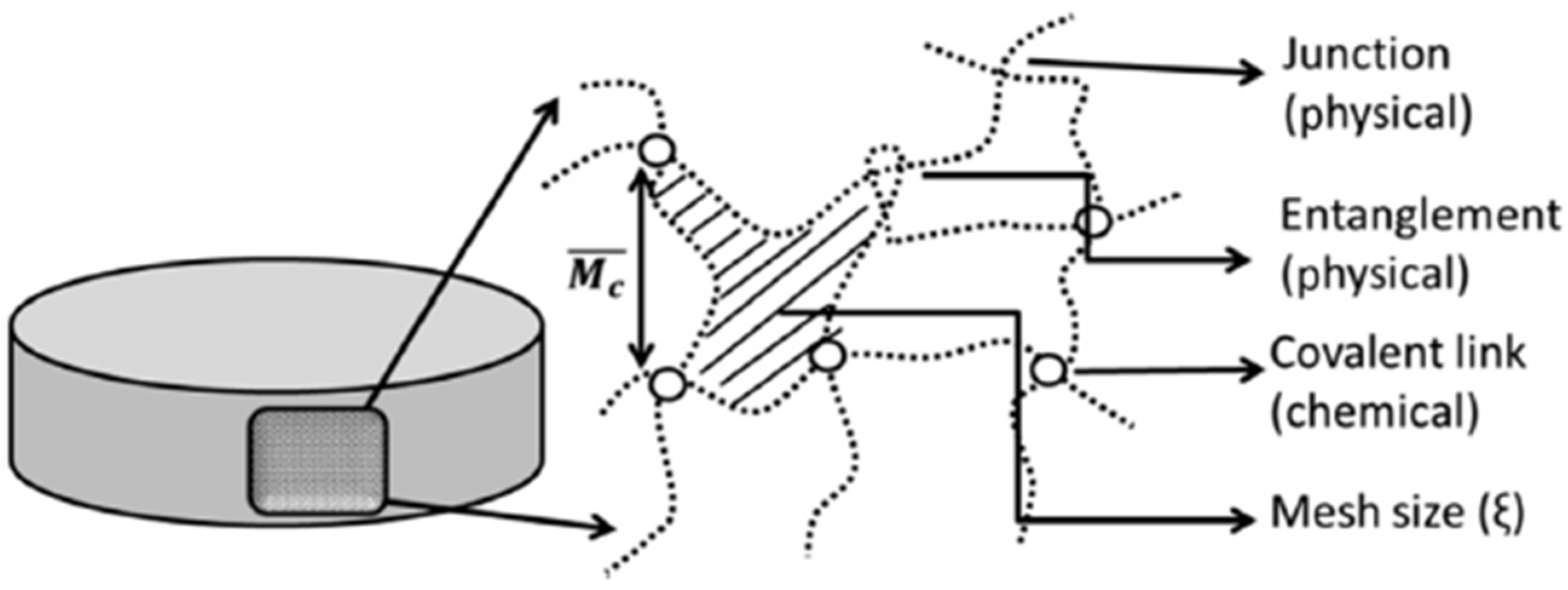
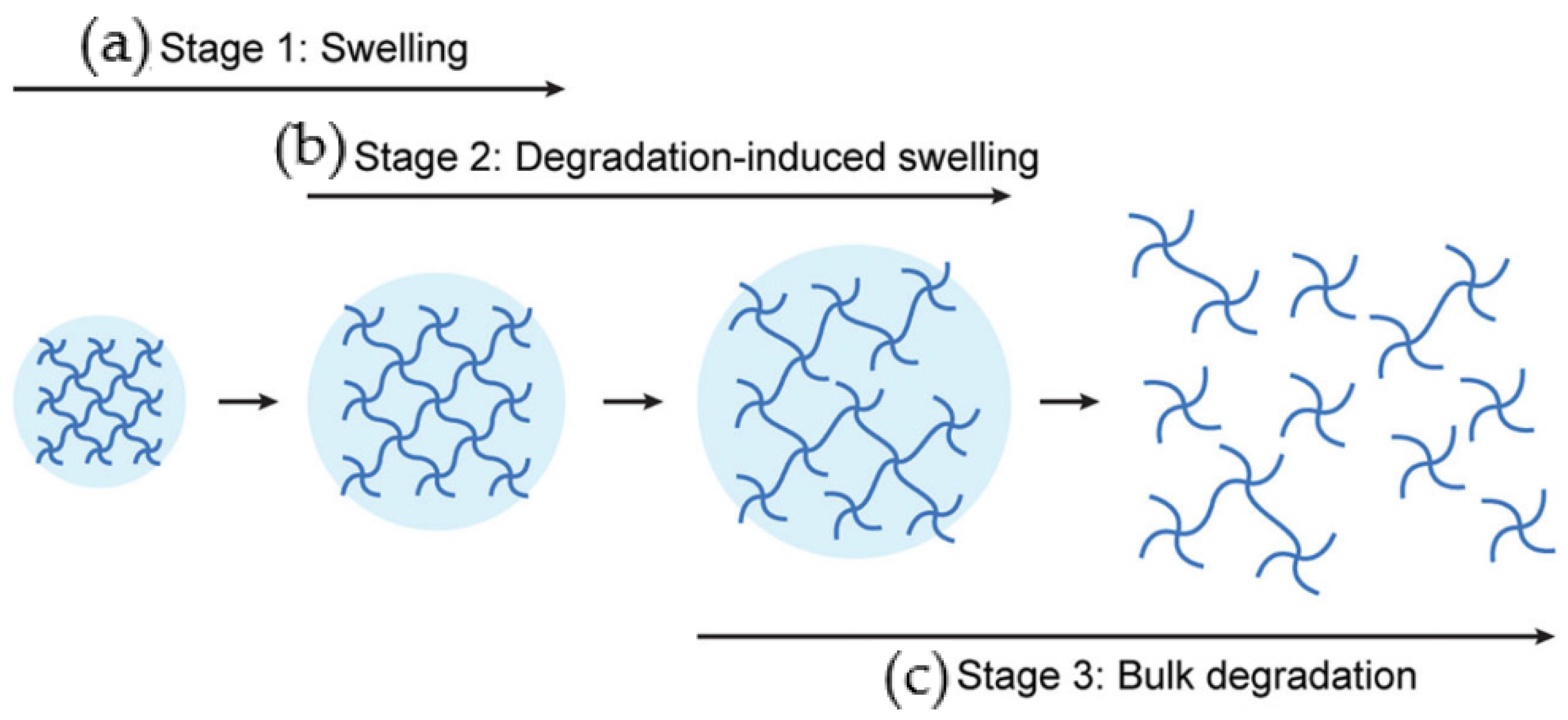

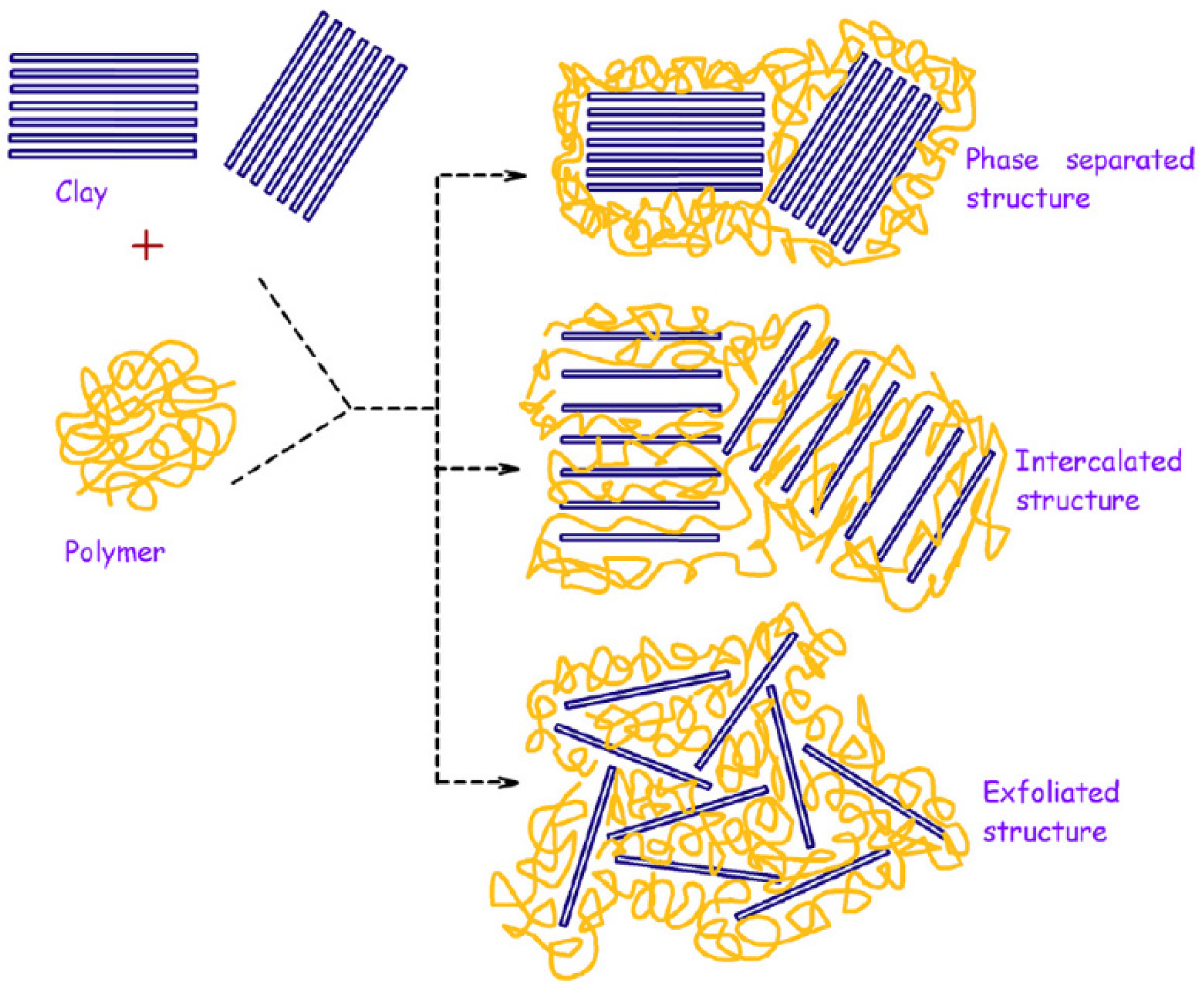
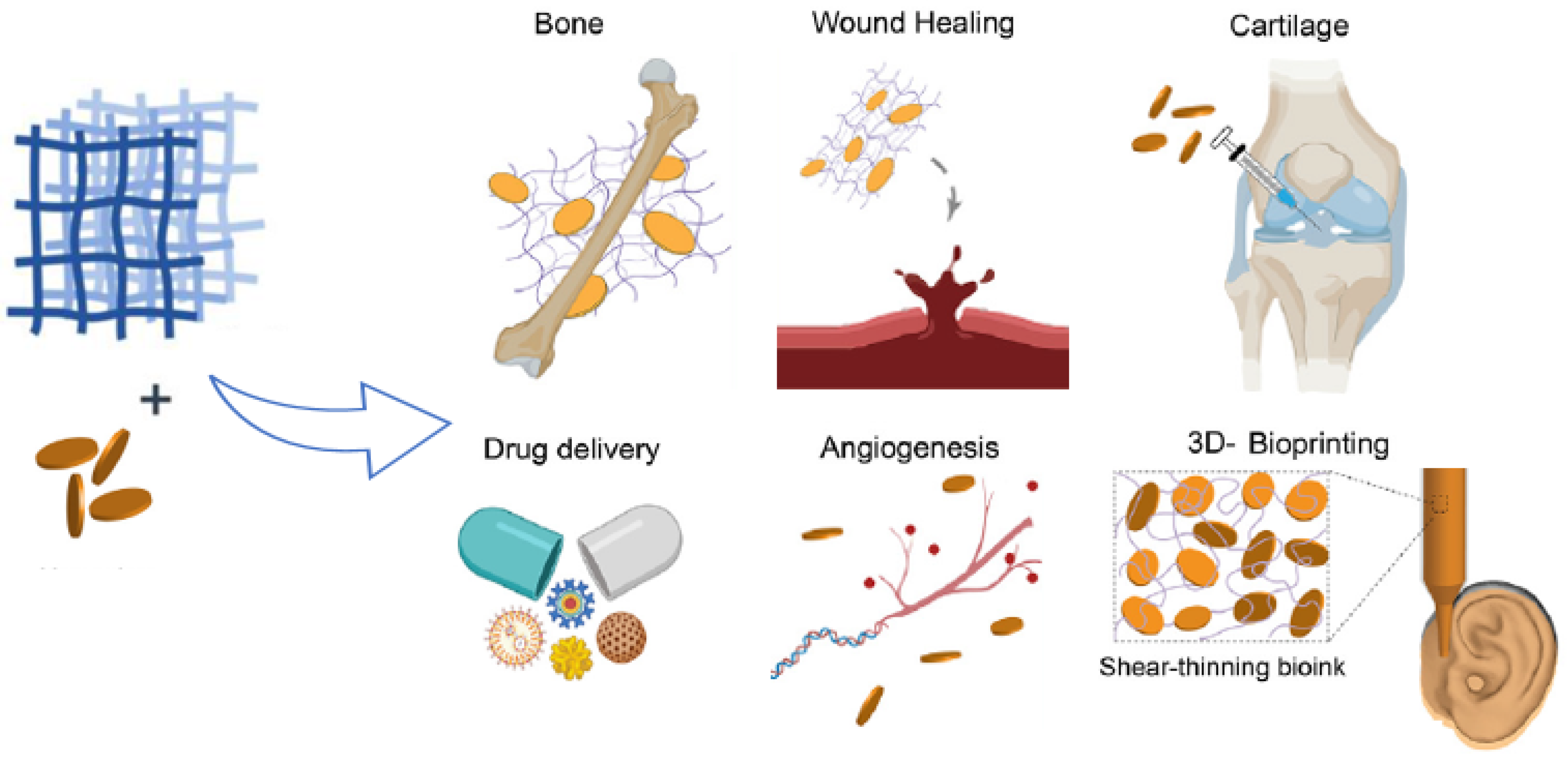
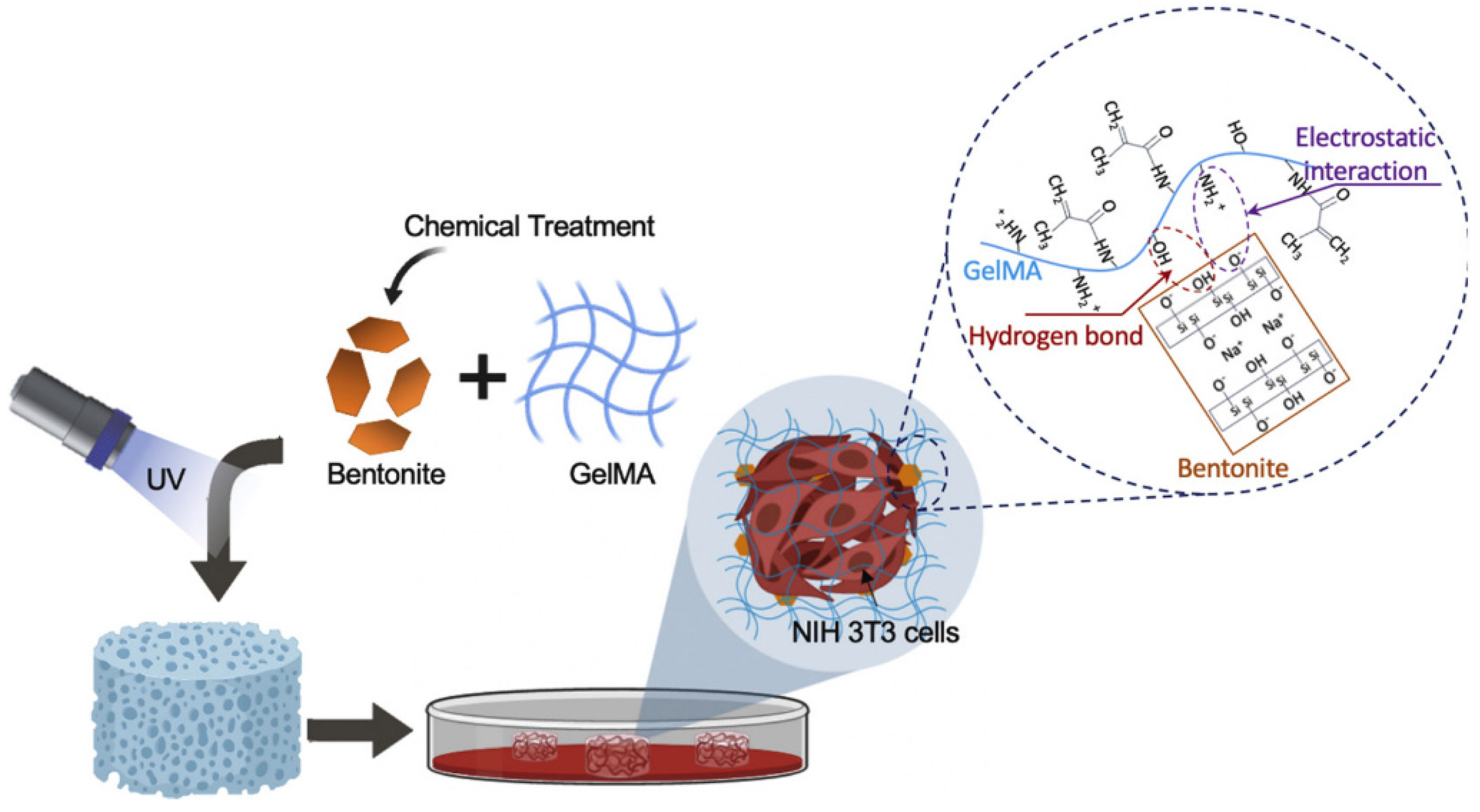
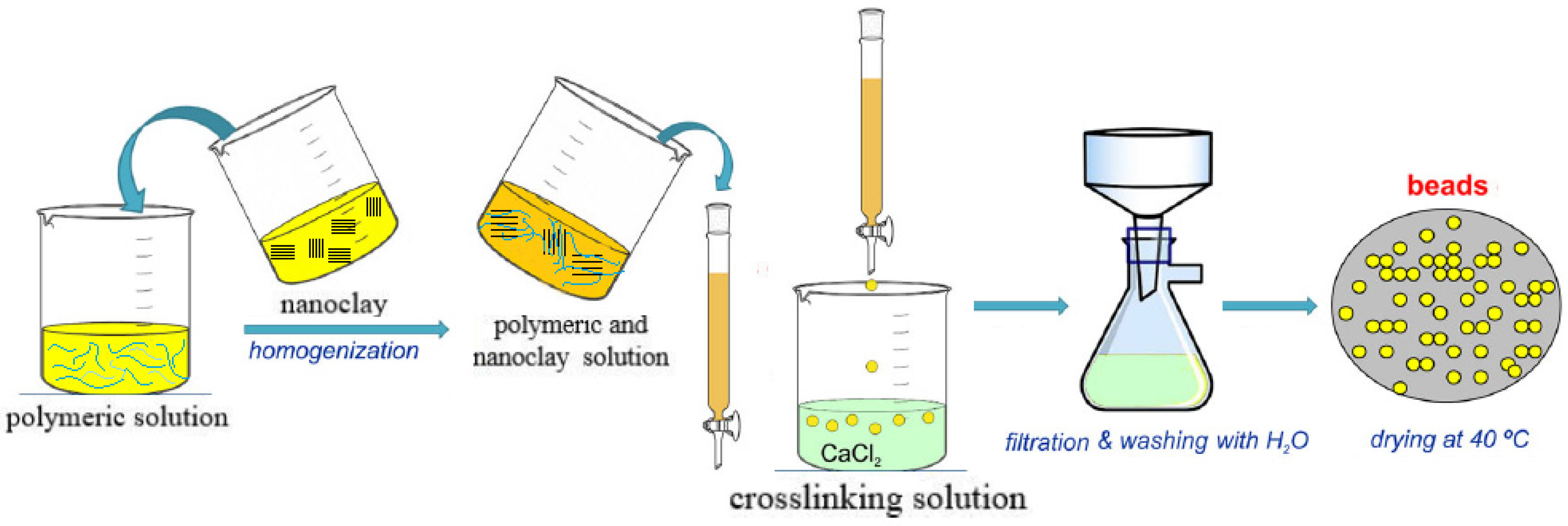




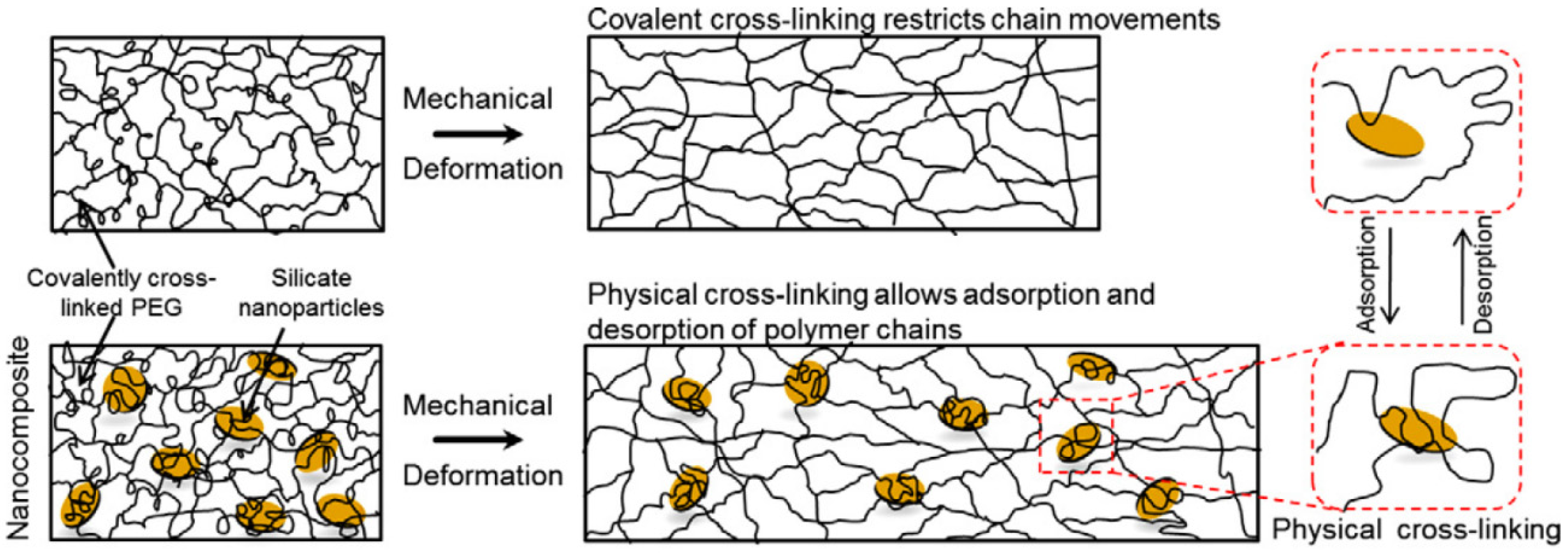
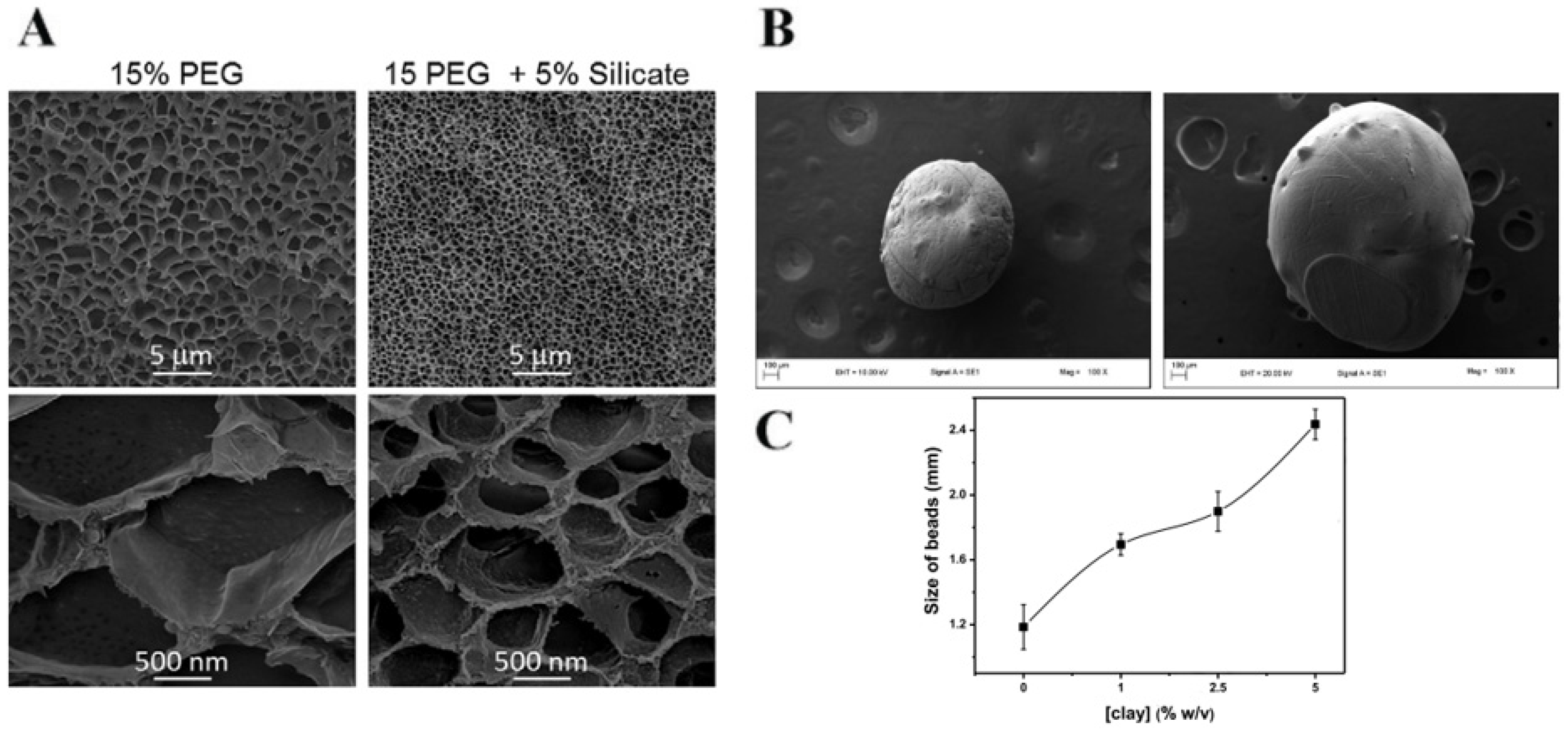
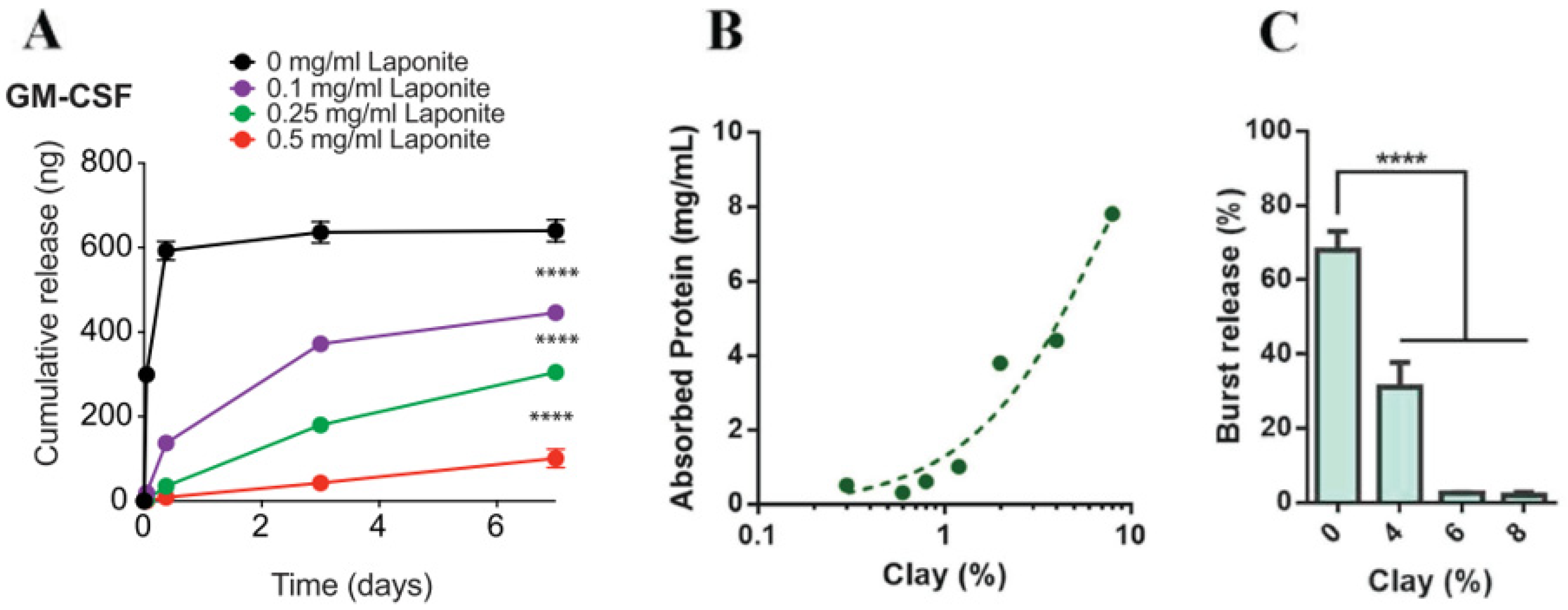
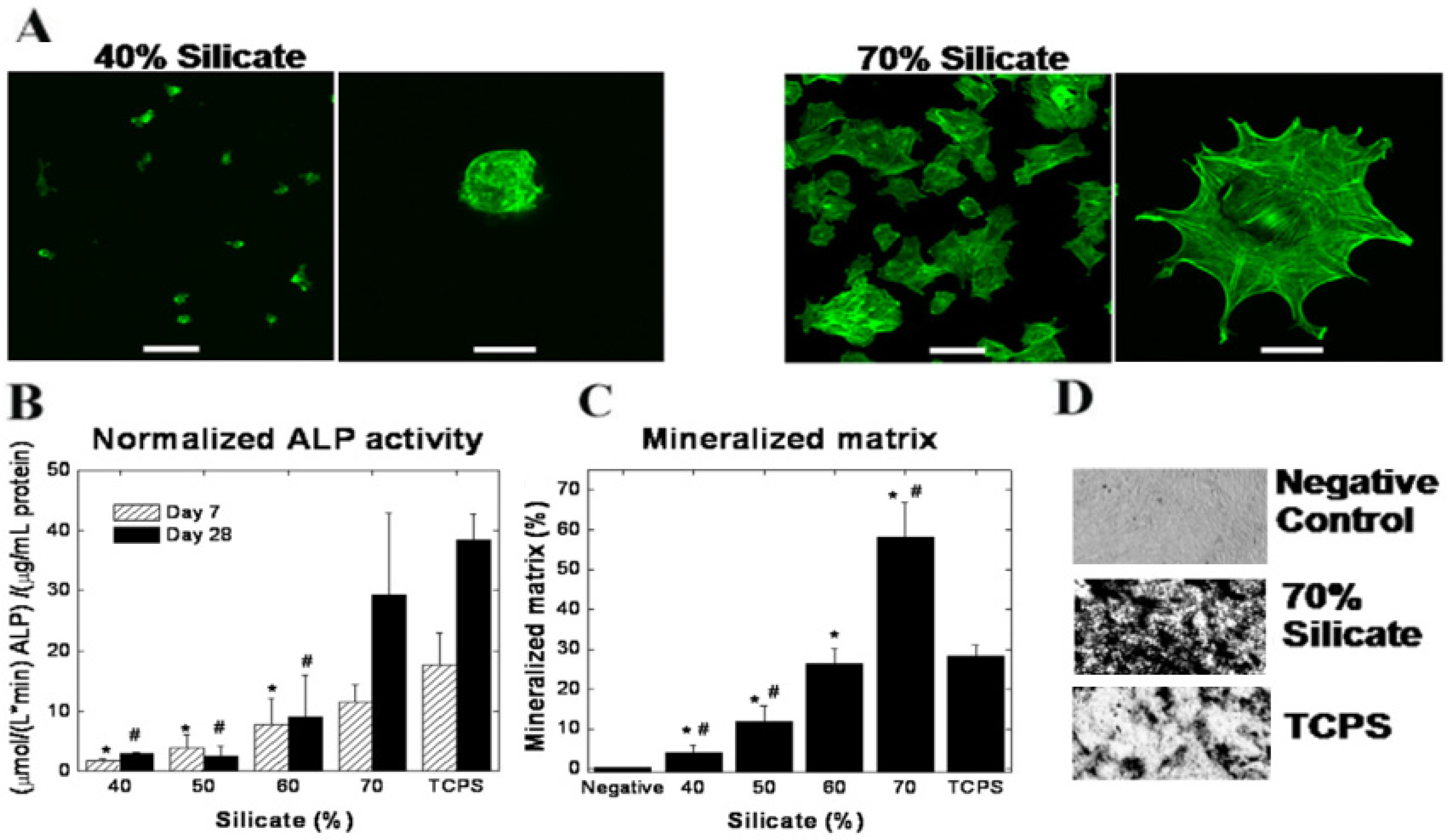



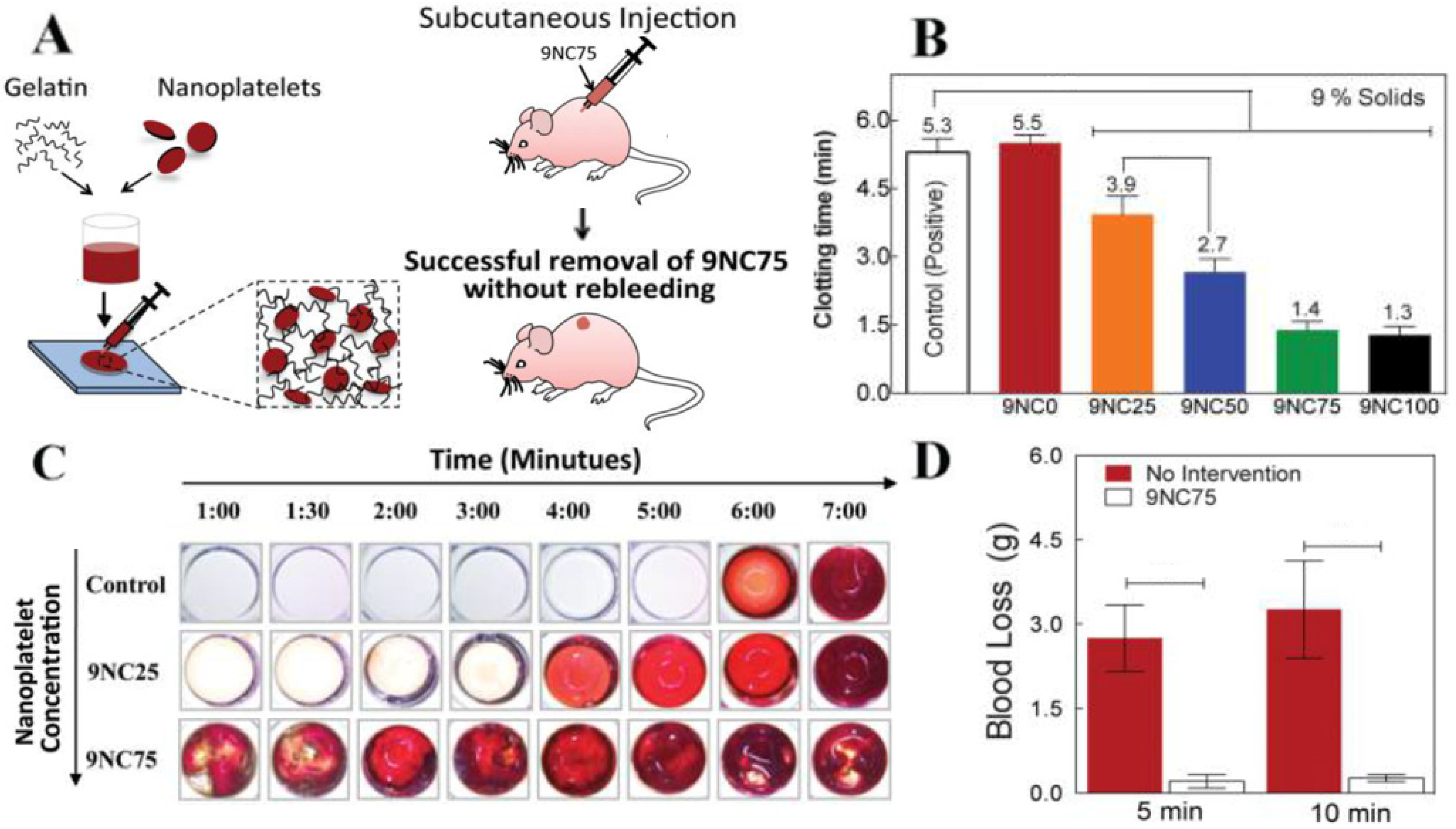
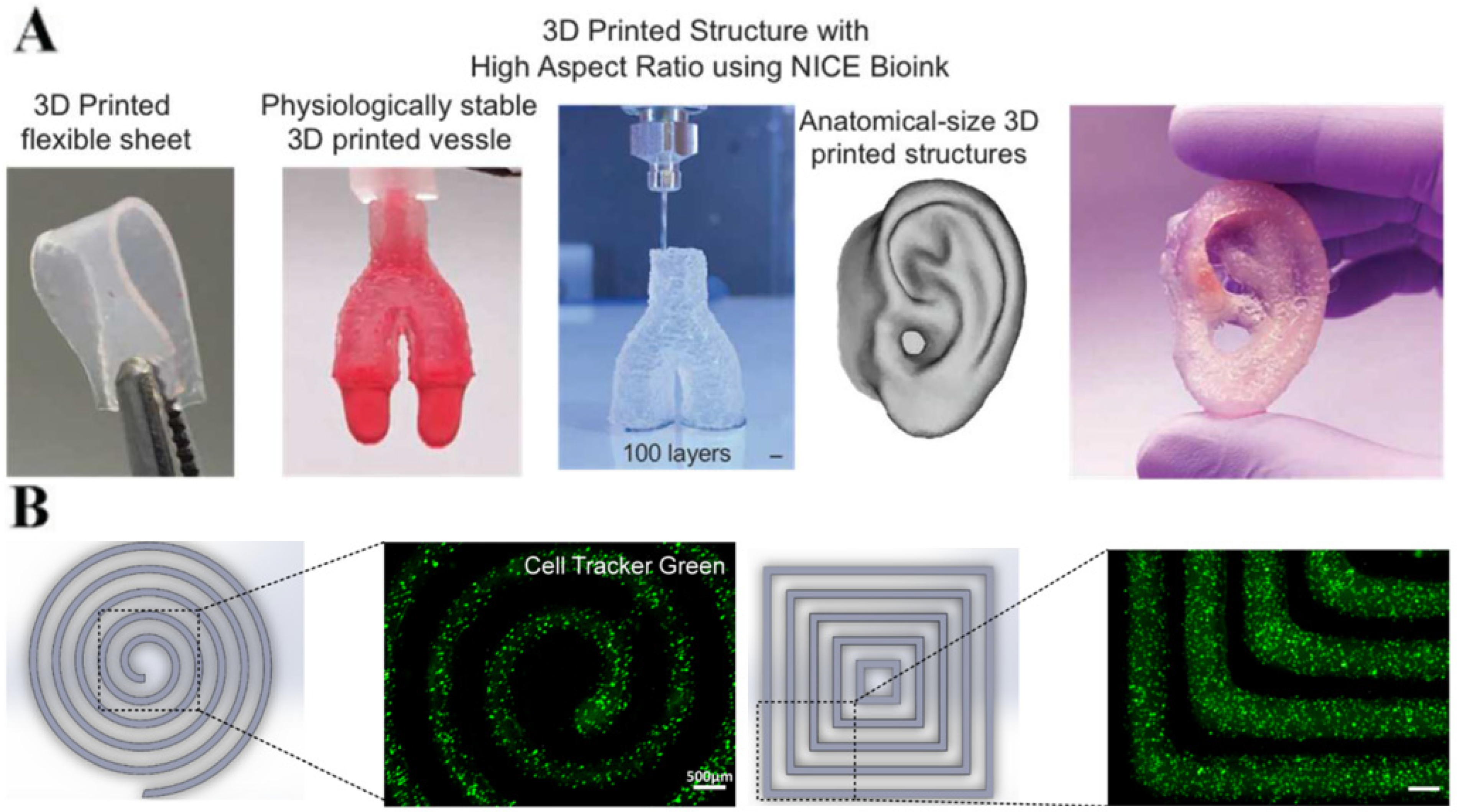
| Hydrogel | Clay | Features/Observation | Ref |
|---|---|---|---|
| PEG | Laponite | Tissue adhesive hydrogel; Subcutaneous implantation in rats with minimal inflammatory response; Laponite addition promoted bioactivity, enhanced cell infiltration and adhesive performance compared to control. | [78] |
| GelMA + MkCA | Laponite | Gradient polymer scaffold reinforced with clay nanosilicates; Mimic native bone-cartilage interfaces; Laponite addition improved control over the mechanical, structural, and biological properties. | [66] |
| Gellan gum + Glycerol | HNT | HNT addition decreased water uptake and improved mechanical properties of the hydrogel scaffolds; Loading 25% of HNT induced higher metabolic activity and human fibroblast cell survival during 7 days of incubation. | [79] |
| PEG | LDH | Bioactive PEG hydrogel crosslinked with LDH coated with polydopamine; Nanocomposites showed self-healing ability, tunable mechanical properties, bio-adhesion; Osteogenic differentiation support of hMSCs. | [61] |
| PEGDA | Laponite | Laponite incorporation increased compressive and tensile properties; Not cytotoxic and supported 2D and 3D cell cultures. | [80] |
| PEO | Laponite | Silicate incorporation improved hMSCs’ attachment, spreading, and proliferation. | [75] |
| SA | HNTs | HNT incorporation improved nanocomposite’s mechanical properties, cell adhesion, and proliferation in preosteoblast (MC3T3-E1) culture. | [60] |
| Hydrogel | Clay | Features/Observation | Ref |
|---|---|---|---|
| Poly(2-methyl-2-oxazoline)-b-poly(2-n-propyl-2-oxazine)) | Laponite | Thermoresponsive hybrid hydrogel exhibited high suitability for extrusion-based 3D printing and structure shape fidelity; Laponite addition retained the thermo-gelling properties, enhanced viscoelastic properties such as increased shear thinning character, and enabled a very rapid viscosity and structure recovery. | [56] |
| GeIMA | Laponite | High laponite concentration significantly improved the hydrogel properties and widened the fabrication window. The nanocomposite hydrogel exhibited improved rheological behaviors, mechanical strength, and stability as well as desirable printability, excellent shape fidelity, and biocompatibility. It also significantly promoted BMSC proliferation, showed high cell viability, proliferation, and osteogenic differentiation. | [76] |
| κCA | Laponite | The enhanced physical interaction between kCA and nanosilicates allow the printability of complex physiologically relevant tissues due to improved mechanical strength, structural integrity, and high shape fidelity of the printed filament. | [63] |
| Alginate, Methylcellulose | Laponite | Incorporation of laponite nanoparticles improved printability, increased shape fidelity, and conveyed a sustainable release profile of proteins (BSA and VEGF) and other biologically active agents. | [132] |
| Agarose | Laponite | Incorporation of laponite clay caused changes to flow behavior, elastic moduli, and gelation temperature and contributed to the formation of a highly printable hydrogel system which can retain its shape after extrusion through a fine nozzle due to enhanced structural integrity. It also significantly improved the bioactivity of nanocomposite hydrogels by means of the increased metabolic activity of encapsulated cells and the ability of cells to extend and change their morphology. | [55] |
| Alginate | Laponite | Laponite and alginate concentrations had significant impacts on the bioink’s overall rheological behavior (shear-thinning characteristic, viscosity profiles, flow points, filament formation, and ink printability). | [64] |
| HA + PEGDA | Laponite | A two-channel 3D-bioprinting method successfully fabricated an osteoblast-laden nanocomposite hydrogel construct. Bioink A (a cell-laden PEG–clay construct), not only facilitated 3D-bioprinting, but also encapsulated osteoblasts with more than 95% viability and exhibited excellent osteogenic ability, due to bioactive ion release. HA with encapsulated ROBs is applied as bioink B with a view to improving cell viability, distribution uniformity, and deposition efficiency. | [82] |
Publisher’s Note: MDPI stays neutral with regard to jurisdictional claims in published maps and institutional affiliations. |
© 2022 by the authors. Licensee MDPI, Basel, Switzerland. This article is an open access article distributed under the terms and conditions of the Creative Commons Attribution (CC BY) license (https://creativecommons.org/licenses/by/4.0/).
Share and Cite
Tipa, C.; Cidade, M.T.; Borges, J.P.; Costa, L.C.; Silva, J.C.; Soares, P.I.P. Clay-Based Nanocomposite Hydrogels for Biomedical Applications: A Review. Nanomaterials 2022, 12, 3308. https://doi.org/10.3390/nano12193308
Tipa C, Cidade MT, Borges JP, Costa LC, Silva JC, Soares PIP. Clay-Based Nanocomposite Hydrogels for Biomedical Applications: A Review. Nanomaterials. 2022; 12(19):3308. https://doi.org/10.3390/nano12193308
Chicago/Turabian StyleTipa, Cezar, Maria T. Cidade, João P. Borges, Luis C. Costa, Jorge C. Silva, and Paula I. P. Soares. 2022. "Clay-Based Nanocomposite Hydrogels for Biomedical Applications: A Review" Nanomaterials 12, no. 19: 3308. https://doi.org/10.3390/nano12193308
APA StyleTipa, C., Cidade, M. T., Borges, J. P., Costa, L. C., Silva, J. C., & Soares, P. I. P. (2022). Clay-Based Nanocomposite Hydrogels for Biomedical Applications: A Review. Nanomaterials, 12(19), 3308. https://doi.org/10.3390/nano12193308












